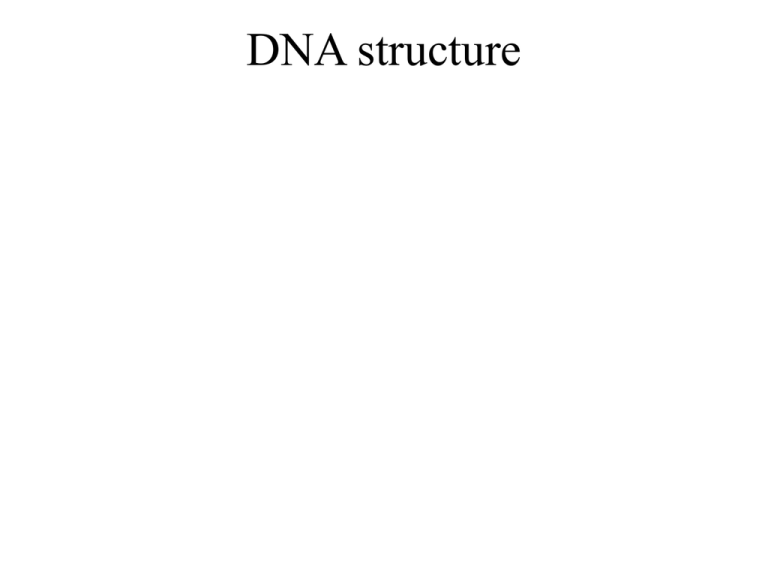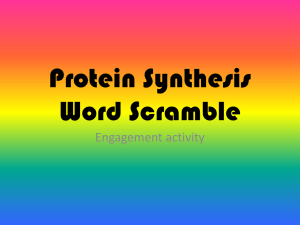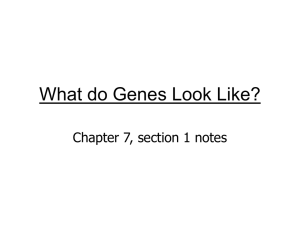
DNA structure
DNA is a polymer made of four monomers (A, T, G, C).
Each monomer is contains:
a. a nucleobase (nitrogeneous base) attached to a sugar
(deoxyribose) and a phosphate.
b. a nucleobase (nitrogeneous base) attached to a sugar
(deoxyribose) and a lipid
c. a nucleobase (nitrogeneous base) attached to an amino
acid and a phosphate.
d. an amino acid attached to a sugar (deoxyribose) and a
phosphate.
True or False:
One end of a DNA strand is called the 5’-end and the other end is
called the 3’-end.
The two strands of DNA are anti-parallel, meaning they run in
opposite directions.
The backbone of DNA (the strands) are composed of sugars
(deoxyribose) attached to each by phosphates.
If you know the sequence of one strand, you can figure out
the sequence of the other.
If the sequence of one strand is 5’-ATGCAT-3’, what is the
sequence of its complementary strand?
The two strands of DNA are held together by Hydrogen bonds
between the nucleobases.
There are three hydrogen bonds holding together G:::C, and two
hydrogen bonds holding together A::T.
Which of the following strands of DNA is most stable?
A.
5’GCGGCC-3’
3’CGCCGG-5’
B.
5’AAAAAA-3’
3’TTTTTT-5’
C.
5’TATATG-3’
3’ATATAC-5’
D.
5’ATGCAT-3’
3’TACGTA-5’
DNA replication
sdfds
What enzyme unzips (unwinds) the DNA molecule?
a.
b.
c.
d.
e.
DNA polymerase
Helicase
Primase
DNA ligase
unzipase
Which of the following are limitations of DNA polymerase?
a. It can only add bases to the exposed 3’ end of a preexisting strand
b. It can only replicate the leading strand
c. It can only replicate the lagging strand
d. None of the above
T or F:
The point where separation of the DNA occurs is called the
replication fork.
Put the following events in the proper order:
a. DNA polymerase extends the RNA primer in opposite
directions using monomers present in the cell.
b. DNA ligase joins together two adjacent strands of DNA
c. Helicase unwinds/separates the two DNA strands
c. RNA primase then adds a short complementary strand
of RNA (a RNA primer) to each strand
d. DNA polymerase extends each strand until it runs into
another section that is already copied
Bidirectional DNA replication
DNA replication in bacteria begins at:
a.
b.
c.
d.
e.
A single origin and proceeds in one direction
A single origin and proceeds in both directions
Two origins and proceeds in both directions
Many origins and proceeds in one direction
Many origins and proceeds in two directions
True or False:
The bacterial chromosome is linear
mRNA synthesis (transcription)
Can you find a mistake in this animation?
The segment of the DNA molecule where mRNA synthesis begins
is called the:
a.
b.
c.
d.
e.
Promoter region
Sigma factor
Transcription terminator
Polymerase
Template
The complementary mRNA stand that would
be synthesized from the DNA sequence
5’-CTGAC-3’ would be:
a.
b.
c.
d.
3’-GACTG-5’
3’-GACUG-5’
3’-CTGAC-5’
5’-CTGAC-3’
The name of the structure that causes the synthesis of mRNA
to cease is called the:
a.
b.
c.
d.
e.
Promoter region
Sigma factor
Transcription terminator
Polymerase
Template
T or F:
The synthesis of mRNA is called translation.
The synthesis of mRNA is in the 5’ to 3’ direction.
The name of the enzyme that synthesizes mRNA is RNA polymerase
Exon Shuffling:
What is the name of the part of mRNA (in the primary
transcript) that does not encode a protein, and is removed by
splicing before a protein is made:
a. Exon
b. Intron
c. Gene
d. 5’cap
e. 3’polyA tail
The 5’-cap and 3’-polyA tails added to mRNA serve what purpose?
a. to make the mRNA more stable
b. to make the mRNA longer
c. to enable splicing out of introns
d. All of the above
One mRNA can be spliced many different ways, including all or just
some of the exons. This allows 30,000 genes in humans to make
over 100,000 different proteins.
This is called:
a. Alternative splicing
b. Intron shuffling
c. Transcription
d. translation
Processing of Gene Information:
Prokaryotes vs Eukaryotes
Which of the following statements is true for eukaryotic
mRNA, but not true for prokaryotic mRNA?
a. A cap is added to their 5’end.
b. A poly-A tail is added to their 3’ end.
c. Each usually specifies only a single protein.
d. All of the above are true for eukaryotic mRNA, and
false for prokaryotic mRNA.
T or F:
Prokaryotic mRNA can be translated by many ribosomes at the
same time as it is being transcribed from DNA, but eukaryotic
mRNA must first be processed and then transported from nucleus
to the cytoplasm before it can be translated into a protein.
An operon consists of a set of related genes that are transcribed as a
single mRNA and are found in eukaryotes.
Transposons:
aka jumping genes
Does anyone know what a bacterial plasmid is?
Transposons are:
a. Segments of mRNA
b. Plasmids
c. Segments of DNA
d. Segments of transfer RNA (tRNA)
Transposons are transported between different cells by:
a. Transduction
b. A sex pilus
c. Conjugation
d. Bacteriophages
e. Plasmids
Which of the following is true about transposons (include all
that are true)?
a. They are capable of moving from one cell to another
b. They can move into the host cell genome
c. They can more from one site in the host cell genome to
another site
d. They can replicate themselves before moving
Addition and deletion mutations
The nucleic acid sequence in mRNA is determined by:
a.
b.
c.
d.
The order of amino acids in the protein
The nucleotide sequence in DNA
The nucleotide sequence in tRNA
All of the above
T or F:
One amino acid in a protein chain is encoded by three
consecutive bases in RNA; the three bases in mRNA that code
for one amino acid is called a codon.
Classify the following three “mutations” as either a
point mutation or a frame-shift mutation.
If it is a frame-shift mutation, is it an addition or deletion?
Original
mutant#1
mutant#2
mutant#3
THE
THE
THE
THE
BIG
BIG
BIG
BIG
FAT
ATC
FAT
CAT
CAT
ATA
CAT
CAT
ATE
TEA
TAT
ATE
ALL
LLT
EAL
ALL
THE
HEI
LTH
THE
ICE
CEN
EIC
ICE
What type of mutation has the least impact on the message?
If a frame-shift mutation creates a stop codon in the DNA
sequence, then
a.
b.
c.
d.
The resulting protein will not be affected
The phenotype will change but not the genotype
The resulting protein will be too short and non-functional
The resulting protein will be too long and non-functional
A nucleotide deletion that occurs during DNA replication:
a.
b.
c.
d.
e.
Causes one amino acid of the protein to be deleted
Causes all of the amino acids of the protein to be incorrect
Causes the amino acids after the deletion to be corrected
Causes the amino acids before the deletion to be incorrect
Has no effect on the resulting protein
Mutations in DNA, such as point mutations or frame-shift
mutations, can be caused by:
a.
b.
c.
d.
e.
Uncorrected errors during DNA replication
Mutagens such as the chemicals found in smoke
High energy particles such as radiation and UV light
Insertion of transposons into an exonic region
All of the above
Restriction Endonucleases
Which of the following could NOT be the recognition site of a
restriction endonuclease?
a.
GAATTC
CTTAAG
b.
ATCGAT
TAGCTA
c.
CTGCAG
GACGTC
d.
GCTTGC
CGAACG
e.
GGATCC
CCTAGG
The single-stranded ends of DNA molecules can be joined
together by:
a.
b.
c.
d.
e.
Restriction endonucleases
DNA ligase
DNA polymerase
Primase
Helicase
Human DNA cut with restriction enzyme A will have the same
sticky ends as (and can therefore be ligated/joined to) which
of the following:
a.
b.
c.
d.
e.
Human DNA cut with restriction enzyme B
Human DNA that is uncut
Bacterial DNA that is uncut
Corn DNA that is cut with restriction enzyme A
None of the above
T or F:
The ligating (joining) of sticky ends involves the formation of
phosphodiester bonds.
If you have a piece of bacterial DNA that is 1280 bases long,
and you add to it a restriction endonuclease that recognizes and
cuts the following sequence:
5’-CATG-3’
3’-GTAC-5’
approximately how many times will the bacterial DNA be cut?
Hint: if you flip a coin four times, how often to you expect to get
heads four times in a row?
PCR: Polymerase Chain Reaction
PCR requires all of the following except:
a.
b.
c.
d.
e.
Primers
DNA ligase
DNA polymerase (usually Taq DNA polymerase)
At least one strand of DNA (polymer) to copy/amplify
Deoxyribonucleotides (monomers)
The purpose of heating the DNA during each cycle of PCR is to
a.
b.
c.
d.
Activate the polymerase enzyme
Speed up catalysis by the polymerase enzyme
Separate the two strands of DNA template
Increase binding of primers to the DNA template
T or F:
Even though Taq polymerase is an enzyme from a bacteria, it can
copy DNA from any species, including humans.
During the PCR, the hydrogen bonds holding the two strands of
DNA molecules together are broken by the helicase enzyme.
You can determine which part of OJ Simpon’s DNA you wish to
amplify by changing which of the following:
a. The sequence of the primer
b. The temperature of the PCR
c. The amount of polymerase
If you start with one drop of OJ Simpson’s blood, containing ten
cells (and therefore ten copies of his DNA), and you amplify it
by PCR for 10 cycles of “heat-cool-copy-repeat”, how many
copies of the DNA have you made?
What temperature do you think your DNA polymerase works
best at?
Do you think your DNA polymerase works at 95C (nearly the
temperature of boiling water)?
Where do you think scientists found a polymerase that is active
even at very high temperatures, such as Taq DNA polymerase?
Reconstruction of the Primate
Alcohol Metabolic Pathway:
Did Ardi Party Hearty?
QuickT i me™ and a
decom pressor
are needed to see this picture.
Matthew Carrigan
Research Fellow
Foundation for Applied Molecular Evolution
www.ffame.org
Ethanol Metabolism
Ethanol can be a valuable source of energy
NAD
NADH
+
+
OH
O
C
H3C
H
H
ethanol
Adh1
Aldh
C
H3C
O
H
acetaldehyde
C
ATP
ADP
O
O
C
ATP
OPO3=
OH consumed H3C
acetate
acetyl phosphate
H3C
C
H3C
SCoA
acetyl-CoA
O2
Krebs
cycle
paleogenetics
paleogenetics
paleogenetics
paleogenetics
paleogenetics
ADH4: changes across phylogeny
QuickT ime™ and a
decompressor
are needed to see t his picture.
Quick Time™ an d a
d eco mp res sor
ar e n eed ed to s ee this pic tur e.
The most ancient ADH enzyme, node
44
Amount of ethanol that is digested
time (seconds)
QuickT ime™ and a
decompressor
are needed to see t his picture.
Quick Time™ an d a
d eco mp res sor
ar e n eed ed to s ee this pic tur e.
node 44 and 45
Amount of ethanol that is digested
time (seconds)
QuickT ime™ and a
decompressor
are needed to see t his picture.
Quick Time™ an d a
d eco mp res sor
ar e n eed ed to s ee this pic tur e.
node 44, 45, and 49
Amount of ethanol that is digested
time (seconds)
QuickT ime™ and a
decompressor
are needed to see t his picture.
Quick Time™ an d a
d eco mp res sor
ar e n eed ed to s ee this pic tur e.
node 44, 45, 49 and 52
Amount of ethanol that is digested
time (seconds)
QuickT ime™ and a
decompressor
are needed to see t his picture.
Quick Time™ an d a
d eco mp res sor
ar e n eed ed to s ee this pic tur e.
node 44, 45, 49, 52 and 53
Amount of ethanol that is digested
time (seconds)
QuickT ime™ and a
decompressor
are needed to see t his picture.
Quick Time™ an d a
d eco mp res sor
ar e n eed ed to s ee this pic tur e.
node 44, 45, 49, 52, 53 and YOU
Amount of ethanol that is digested
time (seconds)
QuickT ime™ and a
decompressor
are needed to see t his picture.
Quick Time™ an d a
d eco mp res sor
ar e n eed ed to s ee this pic tur e.
node 44, 45, 49, 52, 53 and YOU (and tarsier)
Amount of ethanol that is digested
time (seconds)
QuickT ime™ and a
decompressor
are needed to see t his picture.
Quick Time™ an d a
d eco mp res sor
ar e n eed ed to s ee this pic tur e.
So are you saying we are
adapted to drink ethanol?
Ethanol Metabolism
Ethanol can be a valuable source of energy…
…but if you have too much, a toxic intermediate can accumulate
NAD
NADH
+
+
OH
O
C
H3C
H
H
ethanol
Adh1
Aldh
C
H3C
O
H
acetaldehyde
C
ATP
ADP
O
O
C
ATP
OPO3=
OH consumed H3C
acetate
acetyl phosphate
H3C
C
H3C
SCoA
acetyl-CoA
O2
Krebs
cycle
…and if we (and orangutans)
are adapted to drink ethanol…
then where are all the
drunk monkeys?








